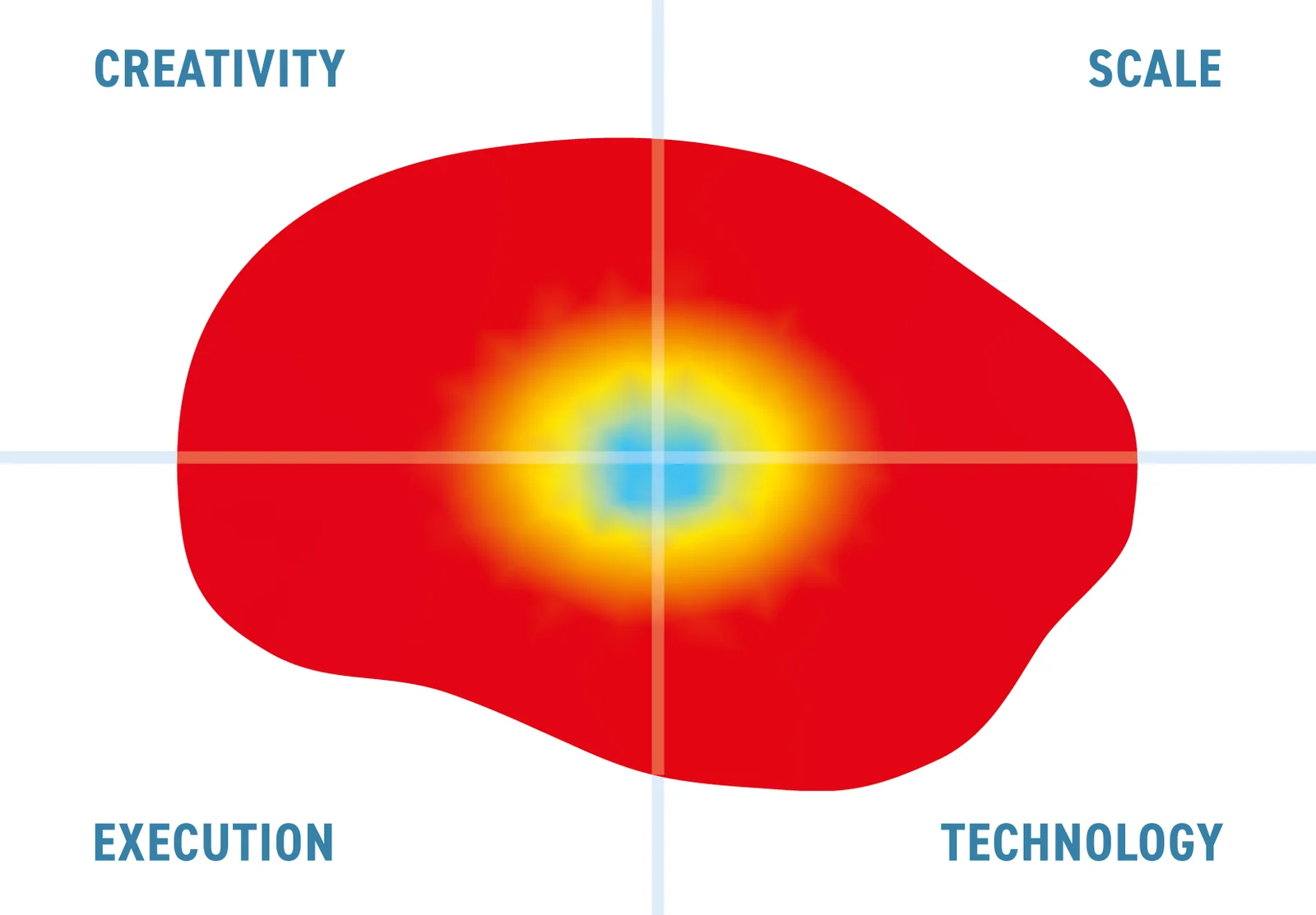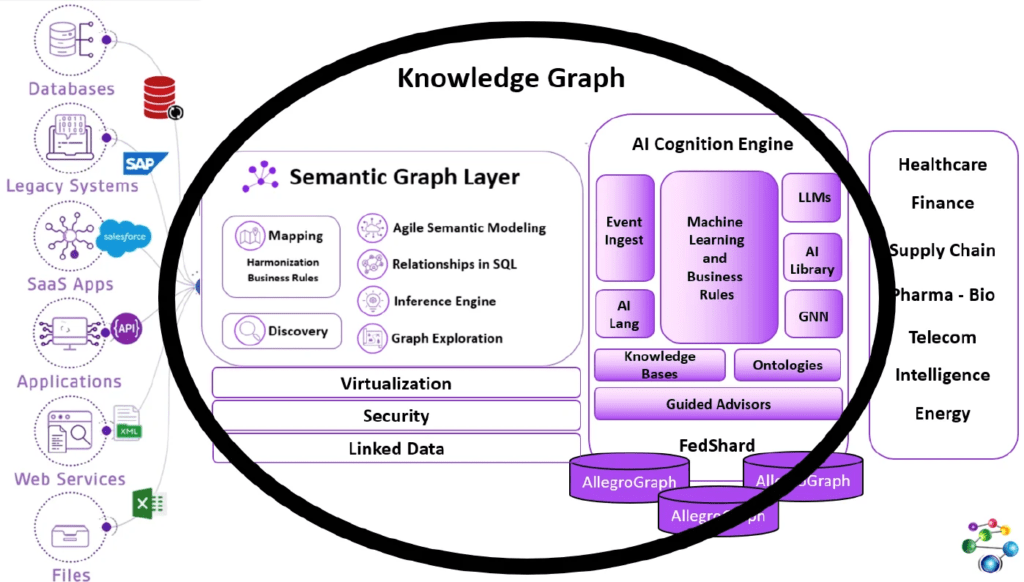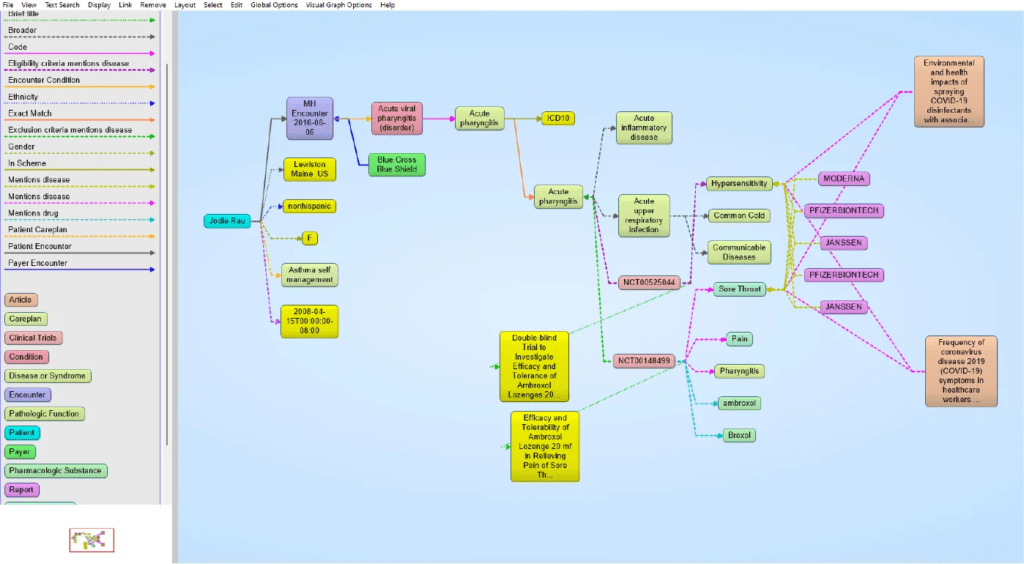AllegroGraph
Update solution on February 7, 2024

AllegroGraph, now in version 8.0, is a platform (see Figure 1) for building semantic knowledge graphs using neuro-symbolic AI, a composite-based AI system that combines symbolic logic, machine learning (specifically, neural networks) and large language models (LLMs). The core of the platform is a semantic graph database: more specifically, an RDF-based quad store (a triple store where all the triples are named) with property graph support. This is augmented with the aforementioned neuro-symbolic AI, which empowers AllegroGraph to analyse, and make meaningful predictions about, your graph data. The result is a knowledge graph that doesn’t just contain the relationships that explicitly exist in your data, but is able to infer the existence of undescribed relationships probabilistically. In fact, probabilities can be directly associated with relationships, representing the likelihood that a proposed relationship is real. More typical inferencing is also supported, including both forward and backward chaining and PROLOG support.

Querying is natural language or SPARQL-driven, and the product offers ‘nDimensional’ indexing for complex values. For example, in a weather application, you could query over a combination of time, location, temperature, pressure and so on. Various graph algorithms and social network analytics are provided out of the box, as is integration with SOLR, Hadoop, and MongoDB. Moreover, it is highly secure, with triple-store attributes that support security and privacy requirements for various government security standards. This includes HIPAA, which is notable because a significant portion of Franz’ current and targeted customer base is in healthcare. The product is OLTP-enabled and fully ACID compliant with immediate consistency. It also supports analytics, which can be used to drive continuous learning.
AllegroGraph can be deployed both on-premises and in the cloud, and is available as a managed service via the recently-released AllegroGraph Cloud. Multiple deployment methods are available, including federated, distributed and hybrid models. The latter uses a sharding approach driven by the company’s patented FedShard technology, which stores replicas of your unshardable data (datasets that must be stored as a single piece) on each of your machines, then federates that data with the repositories located on that machine. This means you only need to load in your unshardable data once for each machine during any given query.
Customer Quotes
“We’re providing live feedback. As you’re typing, we’re providing question and suggestions for you live. AllegroGraph gives us a performant way to be able to work our way through the whole knowledge model and come up with suggestions to the user in real-time.”
Wolters Kluwer
“We are very pleased with our partnership with Franz Inc. and are believers in the power of Semantic Graph Database technology.”
Essilor AMERA
The basic idea behind AllegroGraph is that it will transform your existing enterprise data into triples, which can be thought of as either entities or events, and store them as (part of) a knowledge graph. The initial, and significant, upshot of this is that it makes it much easier to visualise, understand and query your data. This is especially true for complex queries. For example, picking out a single user and obtaining a comprehensive view of their relationships is almost trivial, requiring only a single line of SPARQL. Moreover, Entity-Event Knowledge Graphs (EEKGs) allow you to capture core entities, related events and relevant knowledge bases within a hierarchical tree structure, an example of which is shown in Figure 2. Notably, EEKGs can be built incrementally, starting with a simple model and extending as needed without altering what came before. They also store provenance information and data lineage.

One of the most notable features of AllegroGraph is its capacity for neuro-symbolic AI. The key insight driving this technology is that several types of AI exist, and they each have significant positive and negative traits. LLMs, for instance, are incredibly easy and intuitive to interact with (just look at how they have penetrated the consciousness of the general public) and can provide access to an immense wealth of information. On the other hand, they have already become infamous for their tendency to “hallucinate”, generating false information that often seems like it might be true. Symbolic reasoning, on the other hand, is fundamentally consistent and rigorous, since it is based on logical rules, but at the same time all of those rules have to be created manually (and usually by an expert). This severely limits its ability to scale. Neural networks, and for that matter machine learning in general, excel at pattern recognition but operate on a garbage in/garbage out paradigm and can have difficulty explaining their results, which can impact trust and undermine compliance efforts.
Neuro-symbolic AI, and AllegroGraph by extension, employs these three kinds of AI simultaneously so that these negative and positive traits can compensate for one another. For instance, one implementation might use symbolic reasoning to fact-check the results of an LLM, use an LLM to generate an explanation for the output of a neural network, or use a neural network to feed context into a symbolic model. The ideal result is a virtuous cycle, where each technology is able to use the other two to inform and improve its own behaviour. For AllegroGraph, this all surrounds a central knowledge graph that can then utilise this system to estimate the likelihood of future events. These events can then be inserted into your graph with an attached probability that they will occur. The product also provides various additional pieces of support for AI in general and LLMs in particular. This includes a built-in vector store, RAG (Retrieval-Augmented Generation) functionality, and the ability to dynamically check LLM results against your knowledge graph to help ensure that they are grounded in fact.
In addition to all of the above, AllegroGraph features native, near real-time multi-master replication and management; multi-modal input from RDF, CSV, JSON, JSON Lines and JSON-LD files; built-in document storage (comparable to MongoDB) with support for graph algorithms and semantics; natural language processing (NLP), speech recognition, and textual analysis, including entity extraction; and extensive support for a variety of data science tools.
AllegroGraph boasts a range of features which, if not unique, are at least rare. This includes natural language processing, speech recognition and textual analysis, together with entity extraction; EEKGs, in general; and some of the most advanced security capabilities (paid for by a US intelligence agency) of any product in its market. In particular, the aforementioned speech recognition capabilities can be used to extract conceptual meaning from real speech – such as recorded conversations – then store that meaning in a graph and expose it for analysis. Its hybrid federated/distributed deployment methodology capability can also deliver results for highly complex queries across distributed data sets and knowledge bases in real-time.
That said, it is clear that the most significant point in AllegroGraph’s favour is its neuro-symbolic AI model, and more specifically its recent incorporation of LLMs. If neuro-symbolic AI is able to create a system that imbues LLMs with a real sense of reliability and trustworthiness, the sky is the limit on how far the technology could go. Moreover, AllegroGraph is one of, if not the only major database that supports graph, document and vector data while also providing built-in symbolic logic. This makes it uniquely suited for capitalising on neuro-symbolic AI.
The bottom line
AllegroGraph is a highly secure knowledge graph offering that comes with a range of compelling features, not least of which is the implementation of neuro-symbolic AI in combination with LLMs. Especially in the current market, this makes for a very compelling proposition.
Related Company
Connect with Us
Ready to Get Started
Learn how Bloor Research can support your organization’s journey toward a smarter, more secure future."
Connect with us Join Our Community
